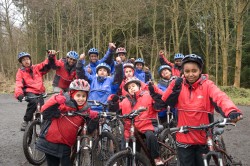Summary
 This work aims to explore and summarise evidence about how children and young people experience nature, including trees and woodlands. It looks at how this contact with nature, whether through school activities and learning or in leisure time, can potentially lead to a wide range of health, wellbeing and learning benefits. It arises from an increasing concern that children are not directly experiencing nature and that this could lead to children missing out on the benefits provided by these interactions.
This work aims to explore and summarise evidence about how children and young people experience nature, including trees and woodlands. It looks at how this contact with nature, whether through school activities and learning or in leisure time, can potentially lead to a wide range of health, wellbeing and learning benefits. It arises from an increasing concern that children are not directly experiencing nature and that this could lead to children missing out on the benefits provided by these interactions.
Research objectives
- To better understand how children and young people experience nature, including trees and woodlands
- Increase understanding of the issues that affect children’s contact with and experience of nature
- To identify barriers that may prevent children’s nature experiences
- To research children and nature issues in different contexts such as learning outdoors, different types of outdoor leisure, young people excluded from school, children on urban housing estates
- To disseminate key findings and guidance
 Results so far
Results so far
The work so far has involved:
- Research into children’s contact with nature in Norway
- Research on how mountain biking contributes to young people’s identity
- Exploring the impacts of Forest School on children and young people
- The role of outdoor learning for young people excluded from school – a woodland social enterprise approach
- Reviewing the Forest Education Initiative
- Understanding how children engage with a small urban woodland in London
- Reviewing research evidence of the role of trees and woodlands in formal education
Status
The work in this area started in 2005 and current work and collaboration with Norwegian researchers started in 2012. Further work is ongoing.
Related Products/Services
Contact
Funders and partners
The work involves the following funders or partners :
- Forestry Commission
- Norwegian Institute for Nature Research (NINA)
- New Economics Foundation
- Plymouth University
- Exeter University
Forestry Commission policy
The Forestry Commission Wood for Health strategy and Woods for Learning strategy recognises that exposure to woodlands and greenspace may help children with behavioural and emotional problems and highlights the importance of outdoor learning
The Government Forestry and Woodlands Policy Statements outlines that children should have the opportunity for outdoor learning
Forestry Commission England provides useful information and guidance to encourage and enable play for children in woodlands
Referenced Publications
Recent
O’Brien, L. Ambrose-Oji, B. Waite, S. 2016. Learning on the move: green exercise for children and young people. In press. In J Barton, R Bragg, C Wood, J Pretty (eds) Green Exercise: Linking nature, health and well-being. Earthscan, London.
Gunderson, V. Skar, M. O’Brien, L, Wold, L. Follo, G. (2016) Children and nearby nature: A nationwide parental survey from Norway. Urban Forestry and Urban Greening, 17: 116-125.
Skar, M. Gunderson, V and O’Brien, L. 2016. How to engage children with nature: why not just let them play? Children’s Geographies.
Skar, M. Gunderson, V and O’Brien, L. 2016. Why do children not play in nearby nature? Results from a Norwegian survey. Journal of Adventure Education and Outdoor Learning.
O’Brien, L. 2014. We have stopped moving: Tackling physical inactivity – a role for the Public Forest Estate in England. Forestry Commission and Forest Research.
Previous research in this area
O’Brien, L. 2010. Are we creating problems for the future? Children, young people and the concept of nature deficit disorder. FR Monograph. Forest Research, Farnham.
O’Brien, L., Burls, A., Bentsen, P., Hilmo, I., Holter, K., Haberling, D., Pirnat, J., Sarv, M., Vilbaste, K. and McLoughlin, J. 2011. Outdoor education, lifelong learning and skills development in woodlands and green spaces: the potential links to health and well-being. In K. Nilsson. M. Sangster. C. Gallis. T. Hartig. S. de Vries. K. Seeland. Forests, trees and human health. Book Chapter 12: 343-374. Springer.
O’Brien, L and Lovell, B. 2011. A Review of Forest Education Initiative in Britain. Report to the Forestry Commission. Pp. 99
Lovell, R. O’Brien, L. Owen, R. 2010. Review of the research evidence in relation to the role of trees, woods and forest in formal education and learning. Report to the Forestry Commission. Pp. 60.
O’Brien, L. 2010. ‘It’s fun to play about in’ children’s health and the outdoors – setting the scene. Countryside Recreation Network.
King, K. 2010. Lifestyle, identity and young people’s experiences of mountain biking. FC Research Note.
O’Brien, E. 2009. (invited paper) Learning outdoors: the Forest School approach. Education 3-13, 37: 45-60.
O’Brien, L. 2008. Forest School and outdoor education in Britain. Dansk Friluftsliv, 74: 8-12.
O’Brien, E. 2006. Social housing and greenspace: a case study in inner London. Forestry, 79: 535-549.
O’Brien, E and Murray, R. 2006. Forest School in England: An evaluation of three case study settings. Environmental Education, 84: 8-9.
O’Brien, E and Murray, R. 2006. A marvellous opportunity to learn: evaluating Forest School in Britain. Forest Research, Farnham, pp45.
O’Brien, E and Murray R 2005. Forest Schools in England and Wales: Woodland space to learn and grow. Environmental Education, 80: 25-27.
Murray, R and O’Brien, E. 2005. Such enthusiasm – a joy to see: an evaluation of Forest School in England. Report for the Forestry Commission.
O’Brien, E. 2005. Tackling youth disaffection through woodland vocational training. Quarterly Journal of Forestry 99: 125-130.
O’Brien, E. 2005. Bringing together ideas of social enterprise, education and community woodland: the hill holt wood approach. Scottish Forestry 59: 7-14.
